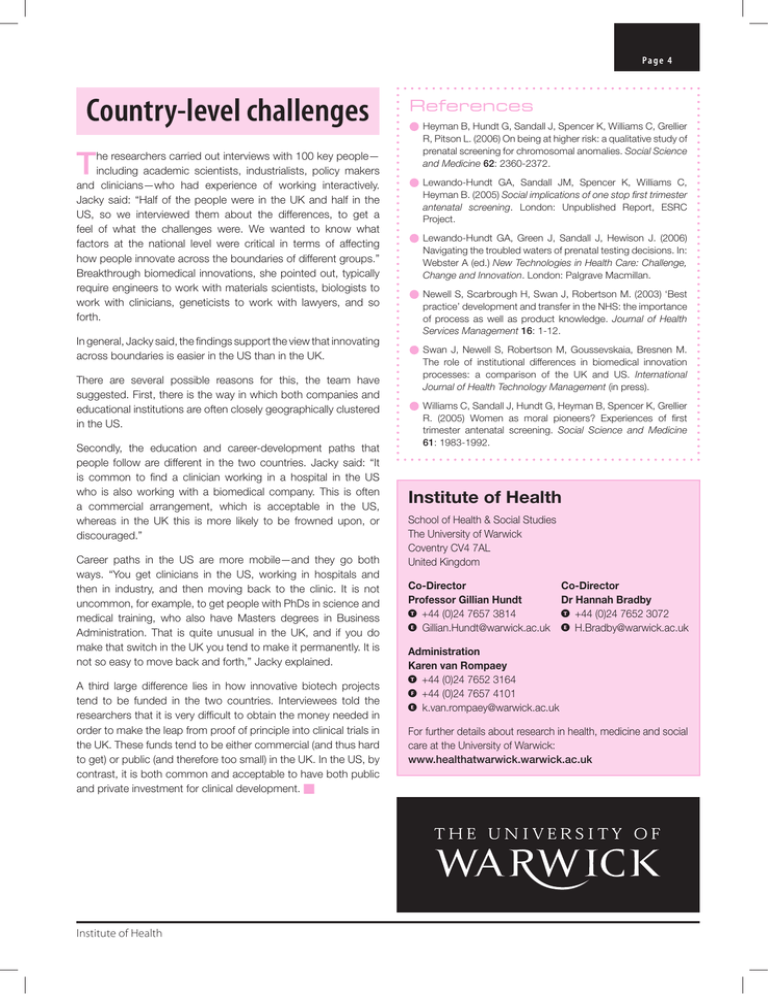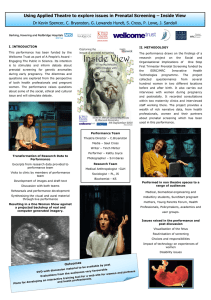Country-level challenges
advertisement

Pa g e 4 Country-level challenges T he researchers carried out interviews with 100 key people— including academic scientists, industrialists, policy makers and clinicians—who had experience of working interactively. Jacky said: “Half of the people were in the UK and half in the US, so we interviewed them about the differences, to get a feel of what the challenges were. We wanted to know what factors at the national level were critical in terms of affecting how people innovate across the boundaries of different groups.” Breakthrough biomedical innovations, she pointed out, typically require engineers to work with materials scientists, biologists to work with clinicians, geneticists to work with lawyers, and so forth. In general, Jacky said, the findings support the view that innovating across boundaries is easier in the US than in the UK. There are several possible reasons for this, the team have suggested. First, there is the way in which both companies and educational institutions are often closely geographically clustered in the US. Secondly, the education and career-development paths that people follow are different in the two countries. Jacky said: “It is common to find a clinician working in a hospital in the US who is also working with a biomedical company. This is often a commercial arrangement, which is acceptable in the US, whereas in the UK this is more likely to be frowned upon, or discouraged.” Career paths in the US are more mobile—and they go both ways. “You get clinicians in the US, working in hospitals and then in industry, and then moving back to the clinic. It is not uncommon, for example, to get people with PhDs in science and medical training, who also have Masters degrees in Business Administration. That is quite unusual in the UK, and if you do make that switch in the UK you tend to make it permanently. It is not so easy to move back and forth,” Jacky explained. A third large difference lies in how innovative biotech projects tend to be funded in the two countries. Interviewees told the researchers that it is very difficult to obtain the money needed in order to make the leap from proof of principle into clinical trials in the UK. These funds tend to be either commercial (and thus hard to get) or public (and therefore too small) in the UK. In the US, by contrast, it is both common and acceptable to have both public and private investment for clinical development. n Institute of Health References l Heyman B, Hundt G, Sandall J, Spencer K, Williams C, Grellier R, Pitson L. (2006) On being at higher risk: a qualitative study of prenatal screening for chromosomal anomalies. Social Science and Medicine 62: 2360-2372. l Lewando-Hundt GA, Sandall JM, Spencer K, Williams C, Heyman B. (2005) Social implications of one stop first trimester antenatal screening. London: Unpublished Report, ESRC Project. l Lewando-Hundt GA, Green J, Sandall J, Hewison J. (2006) Navigating the troubled waters of prenatal testing decisions. In: Webster A (ed.) New Technologies in Health Care: Challenge, Change and Innovation. London: Palgrave Macmillan. l Newell S, Scarbrough H, Swan J, Robertson M. (2003) ‘Best practice’ development and transfer in the NHS: the importance of process as well as product knowledge. Journal of Health Services Management 16: 1-12. l Swan J, Newell S, Robertson M, Goussevskaia, Bresnen M. The role of institutional differences in biomedical innovation processes: a comparison of the UK and US. International Journal of Health Technology Management (in press). l Williams C, Sandall J, Hundt G, Heyman B, Spencer K, Grellier R. (2005) Women as moral pioneers? Experiences of first trimester antenatal screening. Social Science and Medicine 61: 1983-1992. Institute of Health School of Health & Social Studies The University of Warwick Coventry CV4 7AL United Kingdom Co-Director Professor Gillian Hundt T +44 (0)24 7657 3814 E Gillian.Hundt@warwick.ac.uk Co-Director Dr Hannah Bradby T +44 (0)24 7652 3072 E H.Bradby@warwick.ac.uk Administration Karen van Rompaey T +44 (0)24 7652 3164 F +44 (0)24 7657 4101 E k.van.rompaey@warwick.ac.uk For further details about research in health, medicine and social care at the University of Warwick: www.healthatwarwick.warwick.ac.uk Issue 10 2006 update Innovations: ethics, attitudes and obstacles O ne medical engineering student was expecting a lecture on nanotechnology; instead, this student watched Inside View, a one-woman theatrical performance that aimed to stimulate debate about prenatal screening. What better way to focus someone’s mind on the impact on patients of the machines and technologies that he or she may one day design? During September and October 2005, more than 700 people attended performances of Inside View given at the University of Warwick, and at venues around Coventry and in London. Those in the audiences included students, academics, health professionals and parents. Some performances took place in a theatre, but the rest were in lecture theatres, a school, a community centre and a conference centre. Inside View was directed by Claudette Bryanston and performed by Kathy Joyce. Findings from a research study provided the material for the performance, which explored the dilemmas and questions posed by the introduction of routine screening much earlier in pregnancy than formerly, for genetic conditions (such as A way to engage the public G illian Hundt, Professor of Social Sciences at the University of Warwick, said: “We decided to commission this work because we thought it would be a good way to engage the public in the ethical and social issues relating to prenatal genetic screening. We wanted to communicate the issues around the translation of innovation in biomedical science to the public, and the funding from the Wellcome Trust made it possible.” The performance did not promote any particular position on the issues it explored, she added; instead, the aim was to pose questions in the light of an enhanced understanding of these issues. One of the academic foundation stones for Inside View was a study (Lewando-Hundt et al., 2005) that had examined different ways of delivering prenatal screening services. A summary of the key findings of the study, which was funded by the Economic and Social Research Council (ESRC) and completed in 2005, appeared in the programme for the performance. The joint lead investigators Institute of Health Down syndrome), from the perspective of both health professionals and pregnant women. A set with multiple screens made it possible to show relevant images—of ultrasound scans, for example—coupled with soundtracks. During her performance, Kathy Joyce interacted with the visual and aural media. After each performance, the audience could put their views and questions to a multidisciplinary panel. The panel members included a scientist and social scientists involved in the research, as well as the theatre director, actor and media technologist. n were Jane Sandall, Professor of Midwifery and Women’s Health at King’s College, and Gillian Hundt. The study explored the effect of introducing new innovative screening technology on the uptake of screening, and the attitudes of women, their partners and health professionals to screening, in two hospitals that offered different screening protocols. One of the hospitals offered women “innovative” first-trimester screening. The tests included an ultrasound scan of the back of the fetus’s neck (a nuchal translucency scan) and a maternal serum blood test. Women attended this clinic at about 12 weeks of pregnancy, had the tests at the same time as other blood tests and a routine ultrasound scan, and received the results within 1 hour. At the other site, women had a blood test during the second trimester of pregnancy and received the results within 1 week. The first hospital is the only NHS site in England currently to offer one-stop screening in the first trimester. It seems likely, however, that this type of screening will be offered more widely in the future. Pa g e 2 The ‘routinisation’ of testing I n the innovative site, more than a quarter of the women reported that they “never really made up their mind, but went along with what was offered”, compared to just 4 per cent in the hospital with the standard protocol. More than 40 per cent of the women in the innovative site said they had been “offered a screening test as part of routine care and it was assumed I would be having it”, compared to 6 per cent in the standard site. Gillian said: “Overall, this study showed that women like the new technology, and that they were much better informed than we expected. But a minority were not well informed—it is important to take care of the first-time mothers, the younger mothers, and those with low levels of education, who need more explanation to ensure that they can exercise choice.” But one of the questions which this study did not answer, Gillian pointed out, is whether screening that is offered as routine, and is accepted by most women, becomes harder to opt out of, and whether women who choose not to accept it feel stigmatised as a result. Women as ‘moral pioneers’ A further paper, led by another team member, Clare Williams, Reader in the Social Science of Biomedicine at King’s College London (Williams et al., 2005), noted that the introduction of new screening technologies had forced women to take on the role of “moral pioneers”, because of the novel ethical dilemmas that the new technologies pose. Some of the same authors have also contributed to a book chapter for the Innovative Health Technology programme of the University of York, which summarises the latest research into the social implications of new prenatal screening technologies (Lewando-Hundt et al., 2006). In a further paper (Heyman et al., 2006), on which Jane and Gillian are co-authors, the authors explore the views of women who become labelled as at high risk of having a fetus with chromosomal abnormalities. This paper concludes that it is not easy for women to allay their anxieties about the fetus they are carrying once they have been put into a “high-risk” category, and that it is important to keep the time for which they remain “high-risk” and without a diagnosis as short as possible. Institute of Health Opting out or opting in? J ane, Gillian and their colleagues wanted to study the risks and benefits of both “innovative” screening and the more commonly available second-trimester maternal blood test. In particular, they were concerned about how, when an innovation becomes routine, women may find themselves in a situation where they have to opt out of screening, rather than opting in. Jane said: “The Human Genetics Commission has recently highlighted the importance of informed choice and non-directive counselling in order to deliver an ethical UK screening policy. If first-trimester screening becomes routine, however, there needs to be a wider debate about what this means for ethical screening policies. This is vital given the fast pace at which such screening is being introduced.” The ESRC study found that 95 per cent of women attending the site offering innovative screening took up the offer of screening, compared to 63 per cent in the hospital that used the established screening protocol. More than 90 per cent of women in both sites said it was important to them to have the tests early in pregnancy, and to know the results quickly. But almost 40 per cent of women said that they had never discussed what the options would be, after the test, with the person who offered it to them. n Obvious benefits I n many parts of the country, once an optician has identified a patient as having a cataract, the patient then makes six visits to different health professionals spread out over more than a year, before finally having cataract surgery—a routine outpatient surgical procedure that takes about 20 minutes. The new protocol reduced the number of visits to health professionals, and meant that the patient could have surgery within six to eight weeks. Yet, in spite of the obvious benefits to patients and clinicians, implementing the new protocol was no mean feat. The researchers observed that the process of implementing the new system had to allow medical professionals to reconsider and rework their professional boundaries—in other words, to change their ideas of what they should be doing. They also needed to have ownership of the changes, by being involved in bringing them about. This paper concluded: “The process of knowledge generation and its transfer are inexorably intertwined.” n Pa g e 3 Fostering biomedical innovation T hese studies illustrate the importance-when introducing an innovation such as one-stop prenatal screening—of involving the health professionals who will deliver it, the patients to whom it will be offered, and the wider public. Such involvement and consultation is vital to the successful implementation of such innovations—so much so that much research is now being devoted to ways of encouraging such interactivity. Jacky Swan, Professor of Organizational Behaviour at Warwick Business School, and colleagues, have been investigating the Bridging versus bonding J acky and her colleagues make the distinction between the “bridging” that goes on in the UK and the “bonding” that happens in the US. “In the UK, the different stakeholder groups that are involved in a project tend to stay separate, but are encouraged to talk to each other, often pushed by government initiatives aimed at networking—it is a bridging mentality,” Jacky said. “In the US, bonding between groups is a more common aspect of day-to-day work—demarcations between professions are less tightly defined and people often have hybrid or dual careers.” Initiatives in the UK have tried to address this problem by encouraging people from different backgrounds--for example, geneticists, clinicians, health service providers, ethicists and social scientists--who are involved in, for example, trying to develop new treatments using new genetic science, to communicate with each other and work together. Jacky cites the example of Genetic Knowledge Parks—a series of regional initiatives funded by the Department of Health and the The Anglo-American divide M ore recently, Jacky, together with Maxine Robertson, Anna Goussevskaia and Ademola Obembe, also of the University of Warwick, Mike Bresnen, of the University of Leicester, and Sue Newell of Bentley College in Boston, US, has completed the first phase of a study called “The Evolution of Biomedical Knowledge: Interactive Innovation in the UK and the US”. This study, co-funded by the Innovative Manufacturing Centre at the University of Warwick, which is supported by the Engineering and Physical Sciences Research Council, is one of 13 being funded by the ESRC’s “Evolution of Business Knowledge Institute of Health factors that foster “breakthrough” biomedical innovation—and, conversely, those that can doom promising new developments to failure. Jacky said: “In most cases of biomedical innovation, if breakthroughs in science are to be fully exploited, then novel working arrangements are required. This type of working—which we define as ‘interactive innovation’--involves combining ideas, networking across organisational boundaries, and close collaboration among many different specialist disciplines.” Earlier research by Jacky, with collaborators now at the universities of Leicester and Warwick, and at Bentley College in Boston, US, had tracked the introduction of a new process for diagnosing and treating cataracts in the NHS. This study highlighted the difficulties of rolling out and implementing new treatments in the face of reluctance by those practitioners who had to implement them (Newell et al., 2003). n Department of Trade and Industry. The aim of the six parks in England and Wales was to provide “a vital route for the development of genetics applications for clinical practice”, according to the Genetics Research Programme website. The initiative, set up in 2002, was given £15 million of funding over 5 years. This funding, according to some of the people interviewed by Jacky and her colleagues, has fostered some significant new partnerships, and high levels of trust across the different groups involved. But, after 5 years, the funding is coming to an end—at just the point when these collaborations are beginning to have a real impact, Jacky said. She concluded: “You can’t just throw money at people to encourage them to connect with each other, you have to give them time to connect. This is not going to happen in the biomedical field unless they have something to work on, over a sustained period of time. Our research would suggest that collaboration takes longer to get off the ground in the UK than in the US, and that it does not happen naturally.” n Programme”. The work is being coordinated by IKON (the acronym stands for “Innovation, Knowledge and Organisational Networks”), a research unit based at Warwick Business School. All of the component studies aim to understand and improve organisation and management of interactive innovation projects. Jacky and her collaborators will soon publish a paper reporting the first results from their study (Swan et al., in press). This work compares biomedical innovation projects in the UK and the US, to establish which factors at the national level enable or constrain the collaborative working needed to bring about


